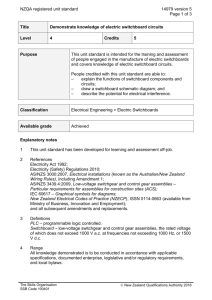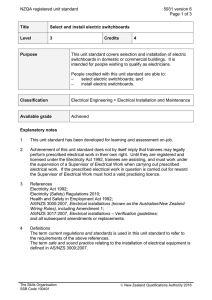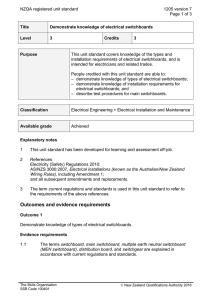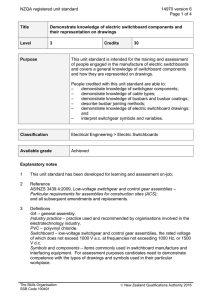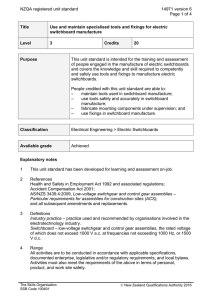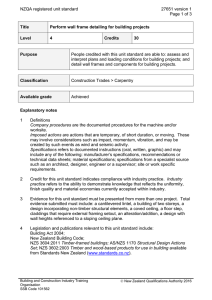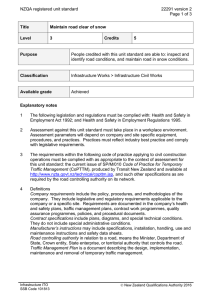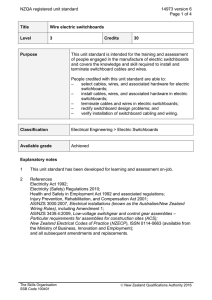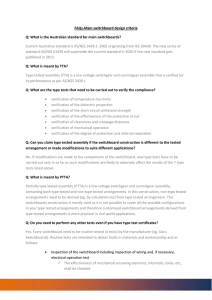NZQA registered unit standard 14972 version 6 Page 1 of 4
advertisement
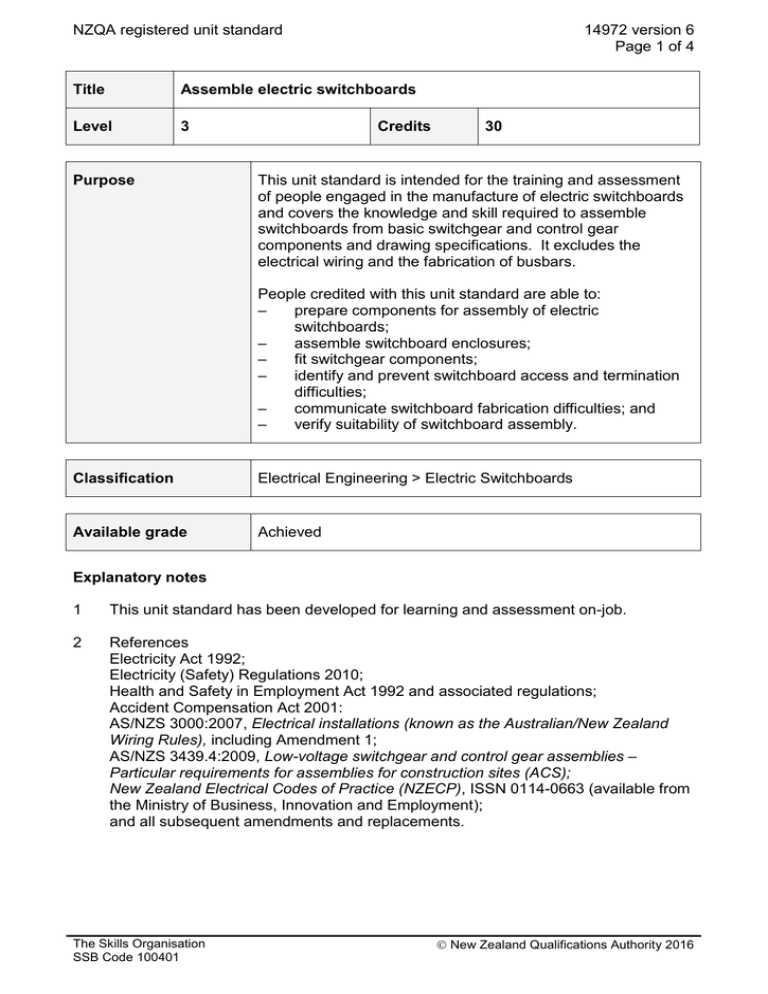
NZQA registered unit standard 14972 version 6 Page 1 of 4 Title Assemble electric switchboards Level 3 Purpose Credits 30 This unit standard is intended for the training and assessment of people engaged in the manufacture of electric switchboards and covers the knowledge and skill required to assemble switchboards from basic switchgear and control gear components and drawing specifications. It excludes the electrical wiring and the fabrication of busbars. People credited with this unit standard are able to: – prepare components for assembly of electric switchboards; – assemble switchboard enclosures; – fit switchgear components; – identify and prevent switchboard access and termination difficulties; – communicate switchboard fabrication difficulties; and – verify suitability of switchboard assembly. Classification Electrical Engineering > Electric Switchboards Available grade Achieved Explanatory notes 1 This unit standard has been developed for learning and assessment on-job. 2 References Electricity Act 1992; Electricity (Safety) Regulations 2010; Health and Safety in Employment Act 1992 and associated regulations; Accident Compensation Act 2001: AS/NZS 3000:2007, Electrical installations (known as the Australian/New Zealand Wiring Rules), including Amendment 1; AS/NZS 3439.4:2009, Low-voltage switchgear and control gear assemblies – Particular requirements for assemblies for construction sites (ACS); New Zealand Electrical Codes of Practice (NZECP), ISSN 0114-0663 (available from the Ministry of Business, Innovation and Employment); and all subsequent amendments and replacements. The Skills Organisation SSB Code 100401 New Zealand Qualifications Authority 2016 NZQA registered unit standard 14972 version 6 Page 2 of 4 3 Definitions Assemble – the mechanical assembly of the switchboard, including the mounting of all switchgear and control gear components and cable ducts, but excludes the installation and termination of cables and wires. Industry practice – practice used and recommended by organisations involved in the electrotechnology industry. Switchboard – low-voltage switchgear and control gear assemblies, the rated voltage of which does not exceed 1000 V a.c. at frequencies not exceeding 1000 Hz, or 1500 V d.c. 4 Range a All activities are to be conducted in accordance with applicable specifications, documented enterprise, legislative and/or regulatory requirements, and local bylaws. Activities must also meet the requirements of the above in terms of personal, product, and work site safety. b This unit standard does not cover switchboard electrical wiring or the fabrication of busbars. These are covered in unit standards 14973, Wire electric switchboards and 14974, Fabricate and install busbars in electric switchboards. Outcomes and evidence requirements Outcome 1 Prepare components for assembly of electric switchboards. Evidence requirements 1.1 Quality, quantity, and type of supplied components are confirmed against assembly specifications. 1.2 Incorrect and/or missing components are identified by referring to assembly drawings, and correct and/or suitable components obtained. Outcome 2 Assemble switchboard enclosures. Range enclosure includes – cabinets, cubicles, frameworks. Evidence requirements 2.1 Enclosures are assembled in accordance with specifications. 2.2 Materials are selected and connected in a manner that optimises production efficiency and meets specifications. The Skills Organisation SSB Code 100401 New Zealand Qualifications Authority 2016 NZQA registered unit standard 14972 version 6 Page 3 of 4 Outcome 3 Fit switchgear components. Evidence requirements 3.1 Components are selected and fitted in a manner that optimises production efficiency and meets specifications. 3.2 Components are attached to the enclosure using fixings and techniques in accordance with manufacturers’ instructions and/or industry practice. 3.3 Components are secured in the positions defined by the drawings and/or within the tolerances specified in the manufacturers' instructions. Outcome 4 Identify and prevent switchboard access and termination difficulties. Evidence requirements 4.1 Components are orientated and positioned during fixing to allow sufficient space for subsequent access and termination in accordance with industry practice. 4.2 Sufficient cable space is provided on assemblies to prevent termination difficulties in accordance with industry practice. Outcome 5 Communicate switchboard fabrication difficulties. Evidence requirements 5.1 Impractical fabrication requirements on drawings are detailed to appropriate person. 5.2 Fabrication options are offered to overcome a perceived fabrication difficulty. 5.3 Fabrication difficulty affecting safety and/or function are communicated in a manner that permits investigation and remedy. 5.4 Authority is obtained for variation to specifications. Outcome 6 Verify suitability of switchboard assembly. Evidence requirements 6.1 All components are confirmed to be installed as indicated on the drawings, subject to authorised variations. The Skills Organisation SSB Code 100401 New Zealand Qualifications Authority 2016 NZQA registered unit standard 14972 version 6 Page 4 of 4 6.2 Dimensions of switchboard are in accordance with specifications. 6.3 Electrical connections on the assembly are marked to show torque settings at specified tensions. 6.4 Shipping breaks are in accordance with specifications. Planned review date 31 December 2014 Status information and last date for assessment for superseded versions Process Version Date Last Date for Assessment Registration 1 31 August 1998 31 December 2013 Revision 2 3 April 2001 31 December 2013 Revision 3 12 March 2002 31 December 2013 Review 4 20 March 2008 N/A Rollover and Revision 5 15 March 2012 N/A Revision 6 15 January 2014 N/A Consent and Moderation Requirements (CMR) reference 0003 This CMR can be accessed at http://www.nzqa.govt.nz/framework/search/index.do. Please note Providers must be granted consent to assess against standards (accredited) by NZQA, before they can report credits from assessment against unit standards or deliver courses of study leading to that assessment. Industry Training Organisations must be granted consent to assess against standards by NZQA before they can register credits from assessment against unit standards. Providers and Industry Training Organisations, which have been granted consent and which are assessing against unit standards must engage with the moderation system that applies to those standards. Requirements for consent to assess and an outline of the moderation system that applies to this standard are outlined in the Consent and Moderation Requirements (CMR). The CMR also includes useful information about special requirements for organisations wishing to develop education and training programmes, such as minimum qualifications for tutors and assessors, and special resource requirements. Comments on this unit standard Please contact The Skills Organisation reviewcomments@skills.org.nz if you wish to suggest changes to the content of this unit standard. The Skills Organisation SSB Code 100401 New Zealand Qualifications Authority 2016
